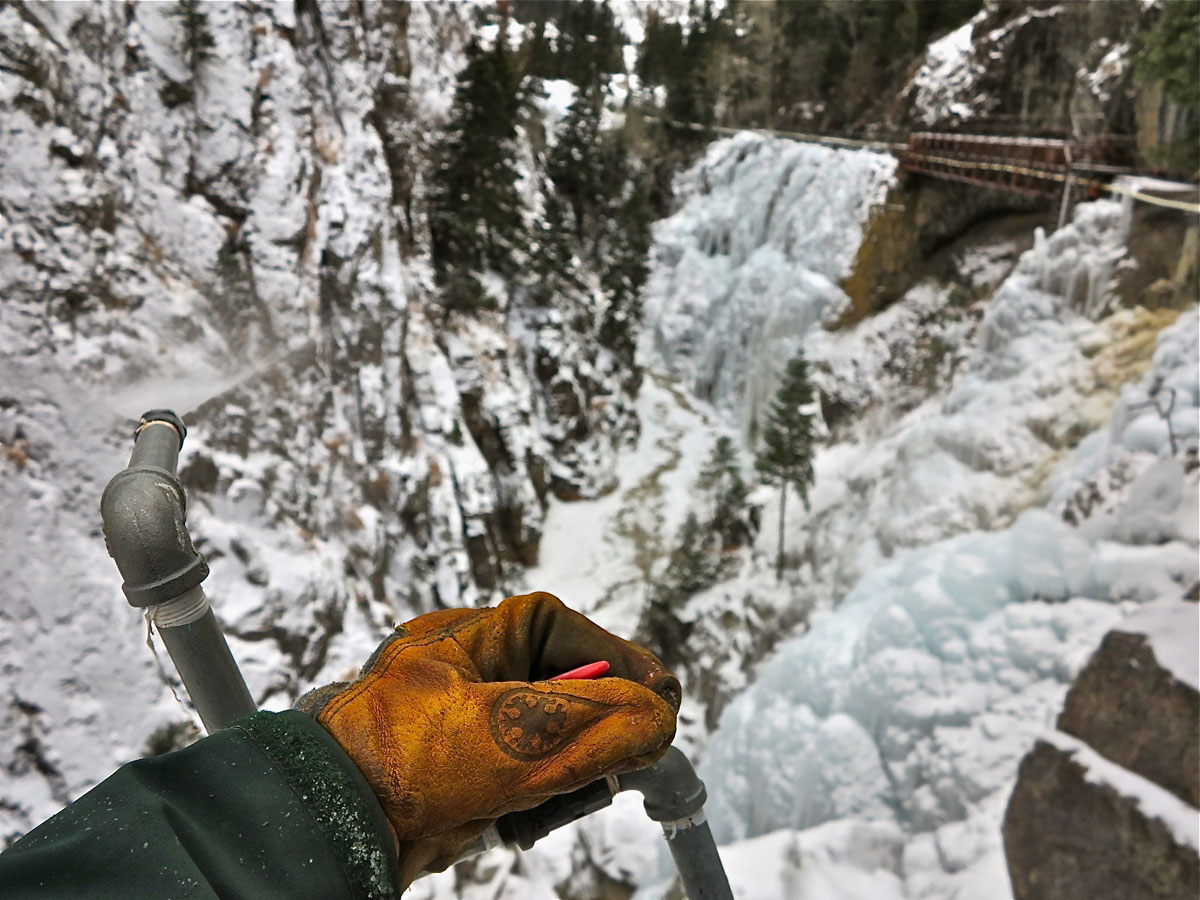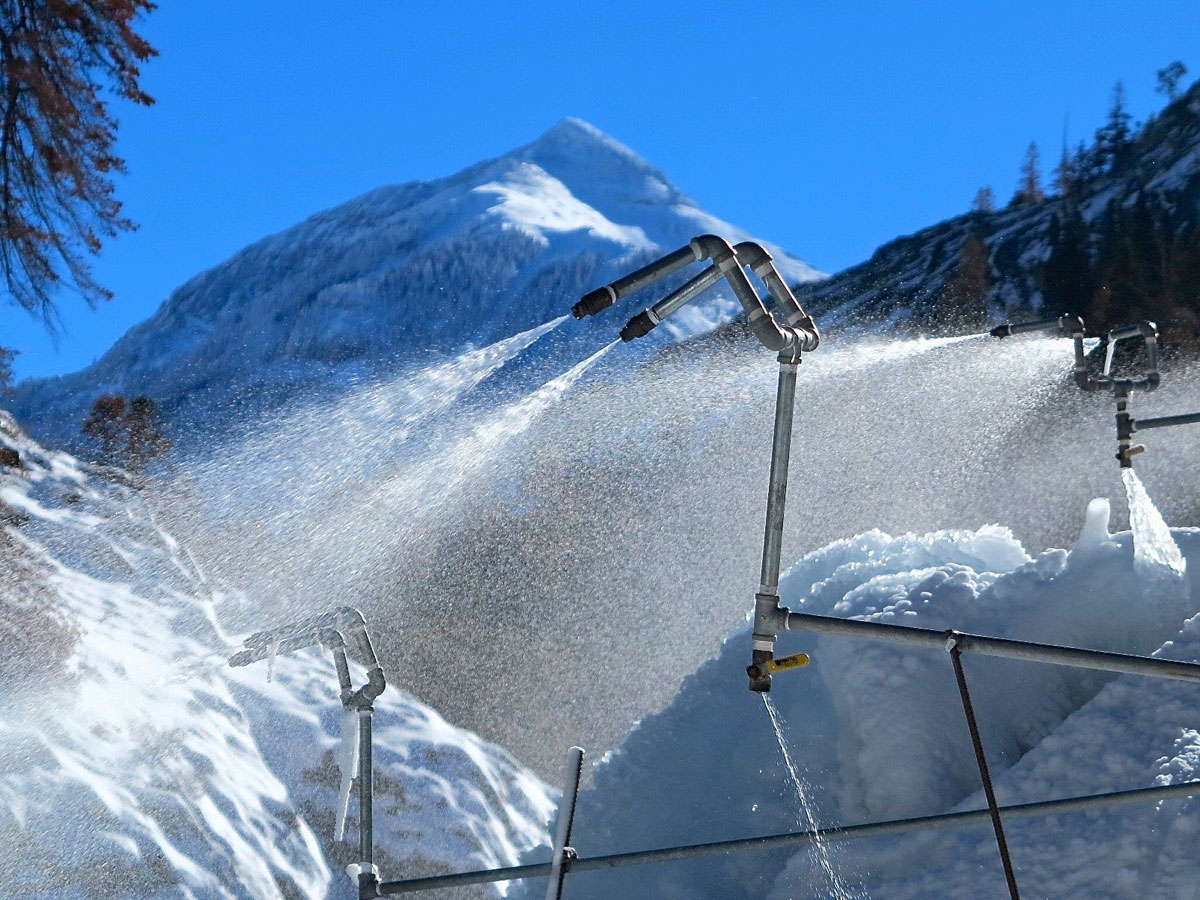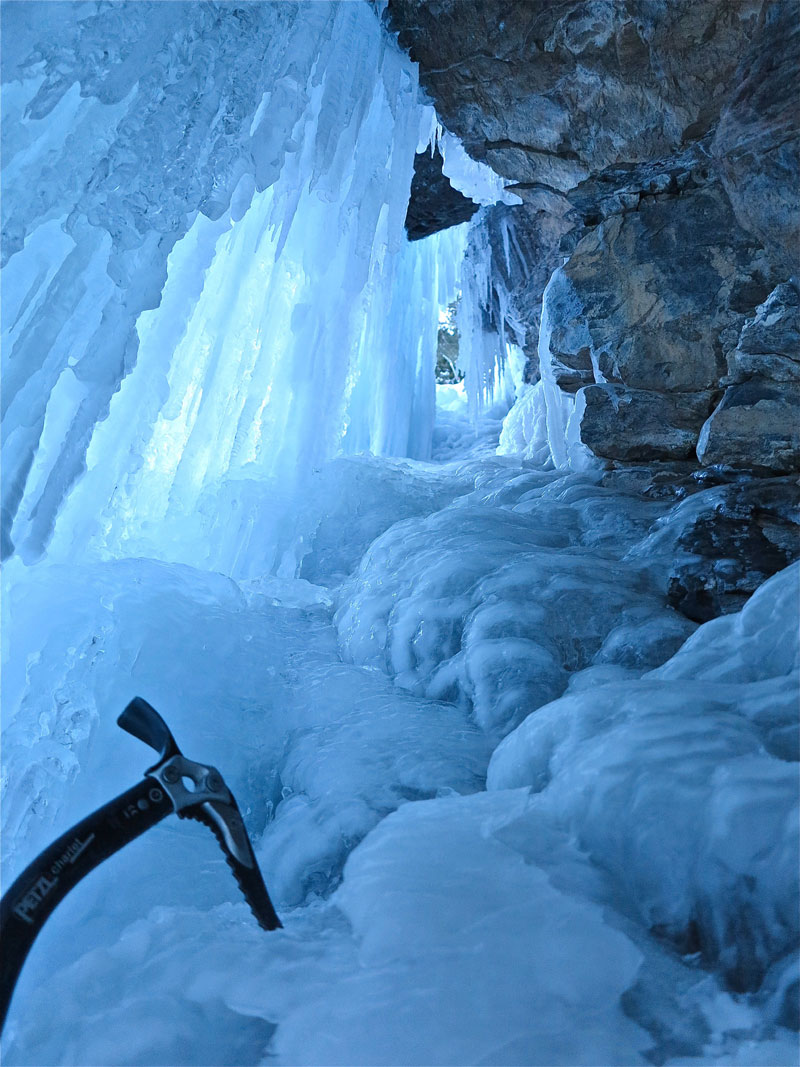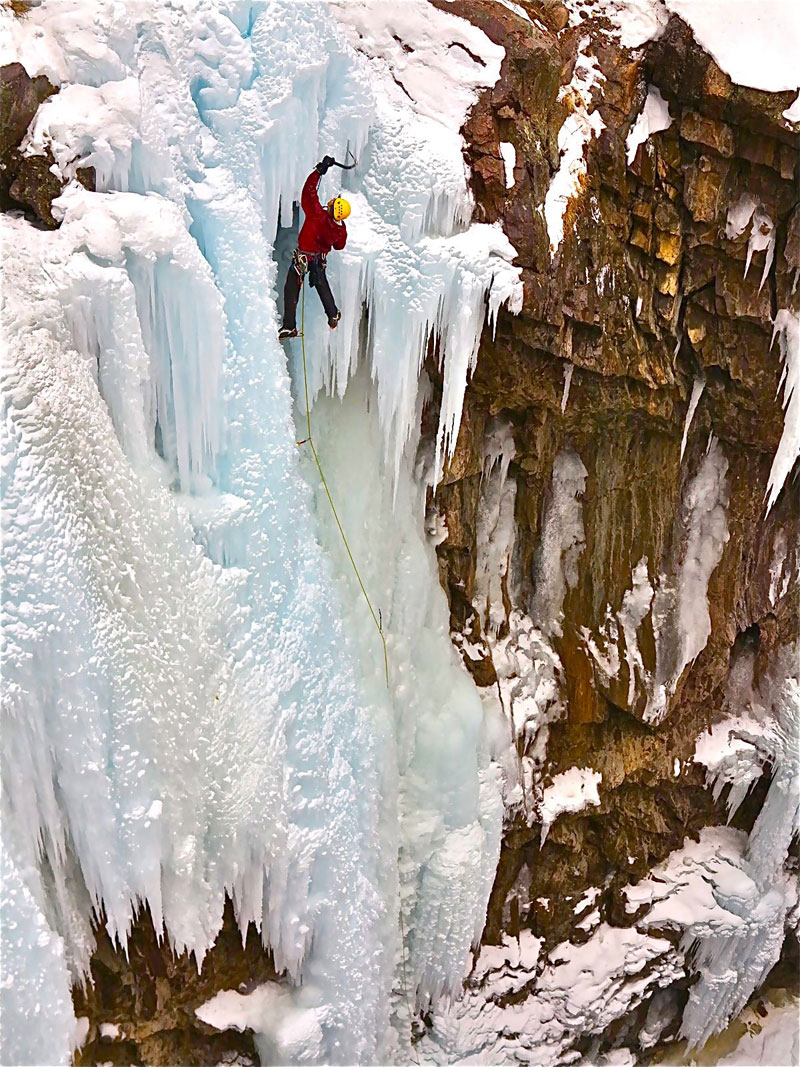Inside the Carefully Cultivated World of Ice Farming
A veteran ice farmer share the tricks of the trade.
Inside the Carefully Cultivated World of Ice Farming
A veteran ice farmer share the tricks of the trade.

The people who create this icy playground are known as ice farmers. Each year as winter approaches, they use a complex system of pipes, irrigation, and shower heads nestled atop the gorge to create towering walls of frozen water.
Ice climbing became popular in the United States during the late 1960s, and although adventurers have been scaling backcountry routes built by Mother Nature for decades, there are now a handful of manmade ice parks in the country. Among them: EXUM Ice Park in Jackson Hole, Wyoming, and Sandstone Ice Park in Sandstone, Minnesota. There are also some smaller outfitters in the Midwest, Northeast, and Alaska with manmade ice climbing routes, but Ouray Ice Park is the biggest and most popular by far, due to its size, variety of climbs, and the fact that climbing in the park is absolutely free.
We spoke with Dan Chehayl, Ouray’s operations manager, to learn more about the unusual profession of ice farming.
Modern Farmer: What exactly does an ice farmer do? That might seem like a strange reference to some people.
Dan Chehayl: An ice farmer is someone who goes out to a rock face or cliff and either diverts water from a nearby source or enhances existing water flow by digging a trench to focus the water in one area. We are farmers! Our season is winter. As soon as the temperatures start dropping every November, we head out in the canyon to “farm some ice.”

MF: How do you create the climbs?
DC: We start by working on our plumbing, or irrigation, system to make sure it is all in working order before we start growing our crop. Another thing we have to do is what we call “deveg,” where we groom the cliff faces to prune all the shrubs and bushes that have grown up over the summer, because they affect the quality of ice we can make. This is a weeklong process.
Once that is all set, we begin running water through our mile-and-a-half long irrigation system to begin the process of making ice. Along the entire system, every five to ten feet or so, there are galvanized pipes that come out of the main supply pipe with valves, shower heads, and drains that give us the ability to make individual climbs in each area.
The actual ice-making process starts by running water through the drains and trying to saturate the cliffs so that the actual ground and rock gets colder and can hold onto and bond with the ice that will soon start to grow.
To get the ice to bond to the rock, we need really cold temperatures – teens are ideal. Once the ice has bonded, the process of making good ice is usually best in the mid to low 20s. Although we can build ice faster in colder temps, it is not as strong. As the temperatures drop more and the rock cools, the water begins to freeze and make teeny icicles and ice bumps all over the place.
We then turn our focus from drains to the shower heads, spraying droplets of different sizes with different types of shower heads to give more or less water to different areas, with the idea of getting the ice to grow. A light spray usually involves more air and smaller droplets so that the water will cool faster and freeze quicker as it hits the ice. A heavier spray will have bigger droplets and less air, and will cool slower giving it the opportunity to reach lower in the gorge to make ice lower down on the longer climbs in the park.
Changing out shower heads and moving them side to side, running water heavier on colder nights and lighter on warmer ones are all little things we do to nurture the ice every day.

MF: Where does the water come from?
DC: Our water is the runoff, or overflow from the city water supply. It comes from a spring in the mountains above town, then runs into our two 500,000 gallon city water tanks. When those are full, the runoff goes to a miniature hydro facility in the summer, and to the Ouray Ice Park in the winter. Either way, the water will eventually end up in the river and headed north. If it is not utilized by the farmers downstream, it will eventually make it to the Colorado River.
We usually start running water around November 20. It can take 20 days to a month [to create the climbs], sometimes more, until the ice is safe and sustainable enough to open to the public.

MF: How did you get into ice farming?
DC: My senior applied research project at Sterling College [in Vermont] was titled “The Benefits of Ice Climbing as Tourism in Mountain Communities.” Little did I know when I started this project that I would end up at the Ouray Ice Park – the best example of this in the world.
I had been a rock climber for many years before I had the opportunity to learn to climb ice in Vermont. I got my start in January 2003 through some professors who did an ice-climbing course my first year for two weeks. The winters out there were very cold, and we had a secret spot in a little gorge that we could top-rope at first. As we got better, we started heading out into the backcountry to climb the ice from the ground up. Every climb was an adventure; it was a way for me to challenge myself and overcome obstacles, and a great way to hang out with friends.
My second year at Sterling College, several of the upper classmen visited Ouray with a professor of mine as part of a “mountain cultures semester.” When they returned to Vermont, it was spring break and they told me about the ice climbing mecca. At this point, I was already head over heels for the sport, so we all jumped into my Volvo station wagon and drove 36 hours straight to Ouray, got out of the car at 7am and started climbing. After that I was hooked on Ouray.
[Two years later] a friend of mine was working as an ice farmer in Ouray and they needed an extra hand, so I was hired on as a part-time ice farmer. I started at the bottom doing all the grunt work – shoveling snow off climbs, clearing anchors, lots of chopping ice bulges around the shower heads, drains and valves, sanding walkways, emptying trash cans. The following year, I began working full time farming the ice.
MF: You refer to Ouray Ice Park as a mecca for climbers. Why is that?
DC: It is the biggest and most popular, period. People do not travel from all over the world or country to go to any ice park other than ours. Our terrain is incredible, breathtaking, and awe-inspiring.
We are located five minutes outside of Ouray – also known as the Switzerland of America. We are in the heartland of many of the North America’s best backcountry ice climbs, so you can train for a few days at the park, then go out into the backcountry and climb a 300-foot continuous classic piece of ice like Bridal Veil Falls, The Ribbon, or Stairway to Heaven. We have about 17,000 feet of vertical ice climbs in the park and we see between seven and eight thousand visitors each season.
MF: What’s the best ice for climbing?
DC: The visiting climbers like ice that is big and fat and blue. Sometimes they like it sticky, like it is in the on warmer, sunny days or a lot of late season; sometimes they like it harder and more brittle. The ice is always different, depending on the weather and the season. That is part of the fun of it – it’s always different. Most people probably like the sticky stuff better – the “hero” ice or “plastic” that you can swing your ice axes in and it sticks automatically and effortlessly.


MF: How does the park benefit both the local community in Ouray County, and the climbing community at large?
DC: Without the Ouray Ice Park, Ouray would be a ghost town in the winter. There was little to no economy before the park really began to take off in the early ’90s. Over the years, as the park grew and became more popular and more climbers visited and moved into town, the economy grew with it, until it eventually became the ice climbing mecca it is today.
The local businesses and the community as a whole rely heavily on the park to keep their businesses going through the winter season. Ouray now has one of the largest climbing communities in the United States. Behind practically every door in town there is at least one climber, and it is a strong community where we are all friends and are all working together to protect our climbing resource and keep it sustainable as it grows each year. It is a very welcoming community as well – new climbers roll into town every day and are welcomed with open arms.
MF: What are your goals for the ice park? Any plans for expansion?
DC: Making the best ice possible, a good experience for the visitors, and safety for staff and visitors are my goals each year.
We are always looking to expand our terrain each year, adding additional climbs where we can. A continued goal is to maximize the benefit to the local community and the broader climbing community as well. Maintaining and improving the infrastructure is also a big focus, as is retention of staff year to year, making this a desirable job.
We are always adding shower heads to the ends of each section in the park to make one or two more climbs. We are also looking to expand some gaps in the park where there are presently no ice climbs or shower heads, but the pipe passes through to get to another area. The reason these places haven’t been developed in the past is either due to accessibility or sun exposure. The places where we are looking to develop a whole new area have poor accessibility because of safe access to the top of the cliff, both for the ice farmers and climbers. We would need to put infrastructure in the form of stairs and walkways to develop this, which entails board approval, city approval, and fundraising.
Check out this video from The Big Story, which show ice farmers in action:
The Ouray Ice Park is free to visitors if you have your own gear. You can also rent gear and take lessons from local outfitters. The park is open from mid-December until late March, depending on the weather.
Follow us

This work is licensed under a Creative Commons Attribution-NoDerivatives 4.0 International License.
Want to republish a Modern Farmer story?
We are happy for Modern Farmer stories to be shared, and encourage you to republish our articles for your audience. When doing so, we ask that you follow these guidelines:
Please credit us and our writers
For the author byline, please use “Author Name, Modern Farmer.” At the top of our stories, if on the web, please include this text and link: “This story was originally published by Modern Farmer.”
Please make sure to include a link back to either our home page or the article URL.
At the bottom of the story, please include the following text:
“Modern Farmer is a nonprofit initiative dedicated to raising awareness and catalyzing action at the intersection of food, agriculture, and society. Read more at <link>Modern Farmer</link>.”
Use our widget
We’d like to be able to track our stories, so we ask that if you republish our content, you do so using our widget (located on the left hand side of the article). The HTML code has a built-in tracker that tells us the data and domain where the story was published, as well as view counts.
Check the image requirements
It’s your responsibility to confirm you're licensed to republish images in our articles. Some images, such as those from commercial providers, don't allow their images to be republished without permission or payment. Copyright terms are generally listed in the image caption and attribution. You are welcome to omit our images or substitute with your own. Charts and interactive graphics follow the same rules.
Don’t change too much. Or, ask us first.
Articles must be republished in their entirety. It’s okay to change references to time (“today” to “yesterday”) or location (“Iowa City, IA” to “here”). But please keep everything else the same.
If you feel strongly that a more material edit needs to be made, get in touch with us at [email protected]. We’re happy to discuss it with the original author, but we must have prior approval for changes before publication.
Special cases
Extracts. You may run the first few lines or paragraphs of the article and then say: “Read the full article at Modern Farmer” with a link back to the original article.
Quotes. You may quote authors provided you include a link back to the article URL.
Translations. These require writer approval. To inquire about translation of a Modern Farmer article, contact us at [email protected]
Signed consent / copyright release forms. These are not required, provided you are following these guidelines.
Print. Articles can be republished in print under these same rules, with the exception that you do not need to include the links.
Tag us
When sharing the story on social media, please tag us using the following: - Twitter (@ModFarm) - Facebook (@ModernFarmerMedia) - Instagram (@modfarm)
Use our content respectfully
Modern Farmer is a nonprofit and as such we share our content for free and in good faith in order to reach new audiences. Respectfully,
No selling ads against our stories. It’s okay to put our stories on pages with ads.
Don’t republish our material wholesale, or automatically; you need to select stories to be republished individually.
You have no rights to sell, license, syndicate, or otherwise represent yourself as the authorized owner of our material to any third parties. This means that you cannot actively publish or submit our work for syndication to third party platforms or apps like Apple News or Google News. We understand that publishers cannot fully control when certain third parties automatically summarize or crawl content from publishers’ own sites.
Keep in touch
We want to hear from you if you love Modern Farmer content, have a collaboration idea, or anything else to share. As a nonprofit outlet, we work in service of our community and are always open to comments, feedback, and ideas. Contact us at [email protected].by Davina van Buren, Modern Farmer
March 10, 2016
Modern Farmer Weekly
Solutions Hub
Innovations, ideas and inspiration. Actionable solutions for a resilient food system.
ExploreExplore other topics
Share With Us
We want to hear from Modern Farmer readers who have thoughtful commentary, actionable solutions, or helpful ideas to share.
SubmitNecessary cookies are absolutely essential for the website to function properly. This category only includes cookies that ensures basic functionalities and security features of the website. These cookies do not store any personal information.
Any cookies that may not be particularly necessary for the website to function and are used specifically to collect user personal data via analytics, ads, other embedded contents are termed as non-necessary cookies.